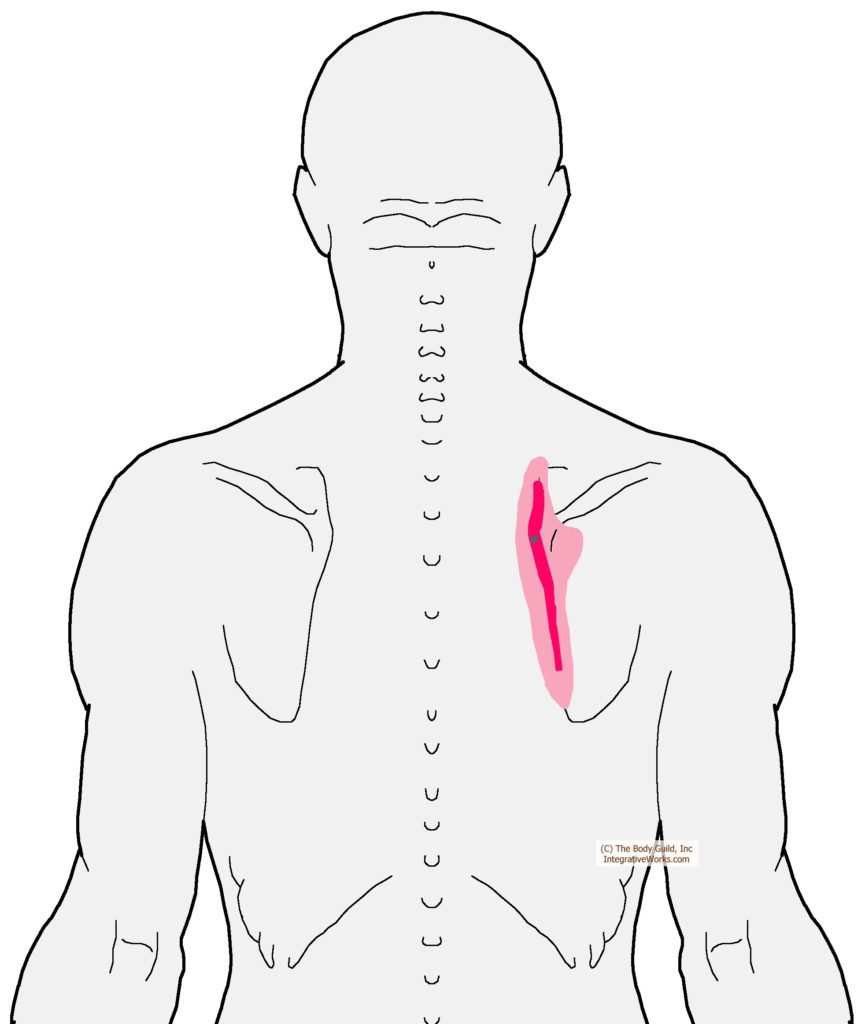Burning and itching along the shoulder blade
Table of Contents
- How People Describe This Pain Pattern
- How You Activate and Intensify This Pain Pattern
- Self-Care – Getting Relief on Your Own
- Musculoskeletal Anatomy Behind Your Pain
- Therapy Notes for Massage and Bodywork
How People Describe This Pain Pattern


People complain of burning along the inside of their shoulder blade. Of course, this burning and itching along the shoulder blade will make you want to rub up against a doorway or get one of those massage canes to get at it. But, in my experience, people quickly notify a body therapist (like me) to rub on it when it bothers them.
This pattern is often the trigger point that makes friends scratch each other’s back for a minute or two. Ahhh. It feels amazing when you rub the shoulder blade at the green spot in this picture. Then, people roll their eyes and say, “yeeaaah, riiiight there…”
Trying Topical Creams
Although some people recognize the muscular ache, others consider this a topical problem on the skin. They may get brief relief if the cream has a numbing agent or tingly feeling. Those agents act on a nerve path that calms the muscle by stimulating the skin. It’s confusing, as the pattern often returns.
How You Activate and Intensify This Pain Pattern
People are unaware of how this started, except that it often bothers them after working at a desk, driving, or working on a low counter. The person, who shall remain nameless, gets this from texting in bed. These activities make this section of muscle work hard to stabilize the scapula as it pulls forward. This posture is often a problem; the person has slumped shoulders with tight pecs.
Jerking Up and Forward
Occasionally, this problem starts when the shoulder jerks forward and up, and this muscle is trying to stabilize the shoulder girdle. For example, this might happen as you kneel to tie your shoe, and the dog on a leash jerks you forward. In another case, a new routine with explosive rotational kettlebell swings activates this. People that slip while using their arms to lower into a seat also get burning and itching along the shoulder blade.
Slumping too.
This burning and itching will bother you as you slump forward while working once you have jerked it and created a little microtrauma. This stretching escalates the intensity of the activated trigger point. The area of burning and itching in this pattern resembles the pain in another pattern that is aggravated by slumping.
This irritation may start with a different trapezius problem that creates a sore neck and shoulder. I explore that pattern in this post. When it is relieved, the burning and itching may reveal itself.
The Musculoskeletal Anatomy Behind Your Pain
Musculoskeletal Anatomy
This post on anatomy contains standard information about the origin, insertion, function, and innervation of muscles. Additionally, it includes information on functional considerations and anomalies.
Find Related Posts
Anatomy posts have a grid of all related posts. This includes posts on pain patterns, self-care, therapy notes, NMT protocols, cranial techniques, and cases.
Getting Relief on Your Own
Clinically Proven
Self-Care Strategies
Self-Care Posts have common sections to make them easy to follow and understand:
- Activities to Avoid or Change
- Strategies for Quick Relief
- Stretches and Exercise for Longer-Lasting Relief
- Yoga Corner
Therapy Notes for Massage and Bodywork
Better Bodywork
Through Shared Expertise
Therapy Notes provide details for cranial, spinal, and local joint work. These notes also link to a traditional neuromuscular protocol.
By treating integrative components first, direct work on the muscle becomes less intense while providing longer-lasting relief.
Support Integrative Works to
stay independent
and produce great content.
You can subscribe to our community on Patreon. You will get links to free content and access to exclusive content not seen on this site. In addition, we will be posting anatomy illustrations, treatment notes, and sections from our manuals not found on this site. Thank you so much for being so supportive.
Cranio Cradle Cup
This mug has classic, colorful illustrations of the craniosacral system and vault hold #3. It makes a great gift and conversation piece.
Tony Preston has a practice in Atlanta, Georgia, where he sees clients. He has written materials and instructed classes since the mid-90s. This includes anatomy, trigger points, cranial, and neuromuscular.
Question? Comment? Typo?
integrativeworks@gmail.com
Follow us on Instagram
*This site is undergoing significant changes. We are reformatting and expanding the posts to make them easier to read. The result will also be more accessible and include more patterns with better self-care. Meanwhile, there may be formatting, content presentation, and readability inconsistencies. Until we get older posts updated, please excuse our mess.